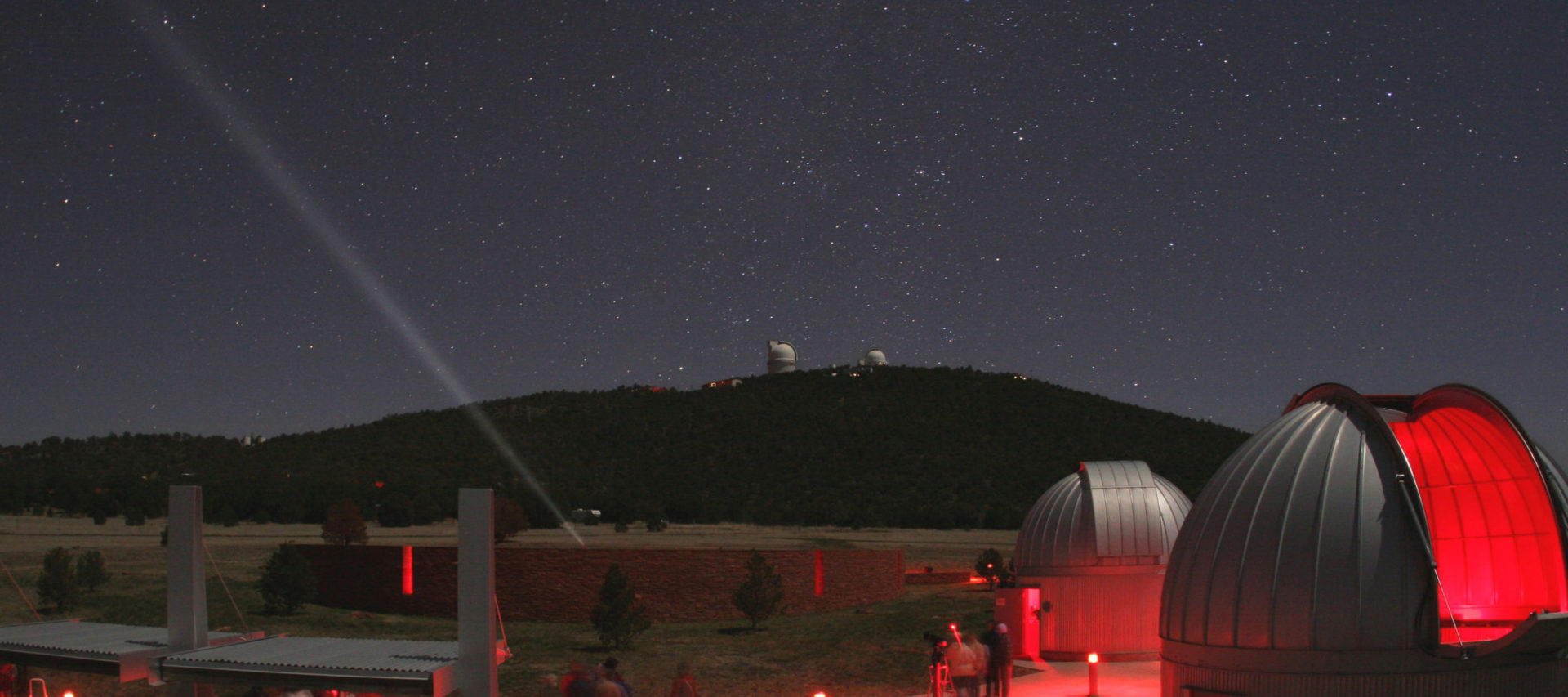

For more than a half-century, America has been a world leader in space, from the space race of the 1960s to the shuttle to numerous deep space probes. But this leadership has often been reluctant — and in tension with a public that has been at best ambivalent and at worst outright opposed to endeavors to explore the universe. Many Americans have little interest in space and would prefer to spend money addressing problems down on Earth. This lack of public support may be why America hasn’t returned to the Moon since the Apollo 17 astronauts lifted off from it in 1972. And so the U.S. space program has yet to achieve its full potential. Despite their love of stories that promote visions of humanity as a space-faring species — such as Star Trek and 2001: A Space Odyssey — Americans haven’t cared enough about the cosmos to fulfill these ambitions.
However, the public space program may be on the cusp of a renaissance. The Trump administration made two momentous decisions bringing us to this point. It declared that America would send astronauts back to the Moon in the 2020s — a goal to which the Biden administration remains committed — and it announced the development of a Space Force as the sixth branch of the military.
Private companies such as Elon Musk’s SpaceX and Jeff Bezos’s Blue Origin have been a vital part of this renaissance. They have freed NASA from its reliance on Russia for travel to space, a constraint for the agency since the 2011 retirement of the space shuttle. They have brought new efficiency to the endeavor by lowering the cost of launches by a factor of twenty compared to the shuttle, and saving the agency hundreds of millions of dollars it would cost NASA to use its own launch system, which is still in development. Moreover, these companies have fueled a resurgence in public attention to space — thanks to Musk’s quest to make humanity a “multi-planetary species,” to tycoons Richard Branson and Jeff Bezos both visiting space themselves this past summer, and to SpaceX conducting the world’s first Earth-orbit tourism mission.
But we have yet to enter an era in which space exploration can be driven solely by private enterprise. By Musk’s own admission, SpaceX would not exist without the business opportunities NASA has provided. Many of SpaceX’s high-profile successes have been conducted on behalf of the U.S. space agency and the International Space Station. Blue Origin and SpaceX continue to vacillate between coaxing and suing the federal government for contracts precisely because they still need it as a customer.
Certainly, many advocates and entrepreneurs hope for a fully developed space economy — one driven by organic, widespread consumer demand rather than by government contracts and billionaire passion projects. But the path to this future remains unclear. Space tourism, zero-gravity manufacturing, and asteroid mining all have promise, but none are commercially viable yet. Instead, the majority of private-sector activity consists of launching and servicing satellites, while for the foreseeable future the public sector will be the main driver for missions to travel to the Moon, Mars, and beyond — and for the research necessary to make these trips possible.
This means that America’s future in space still depends on the American public’s support — which in turn raises several questions for space enthusiasts to ponder. Is the recent surge of attention to space indicative of an actual pro-space turn in public opinion? How do current interest levels compare to the ephemeral excitement of the Apollo era? Why did the public seem so supportive of human space travel in the 1960s but not since? What did Americans want from their space program back when we really seemed to want it? And what do we want now? To the extent that public survey data from the past six decades can shed light on these questions, this essay endeavors to do so.
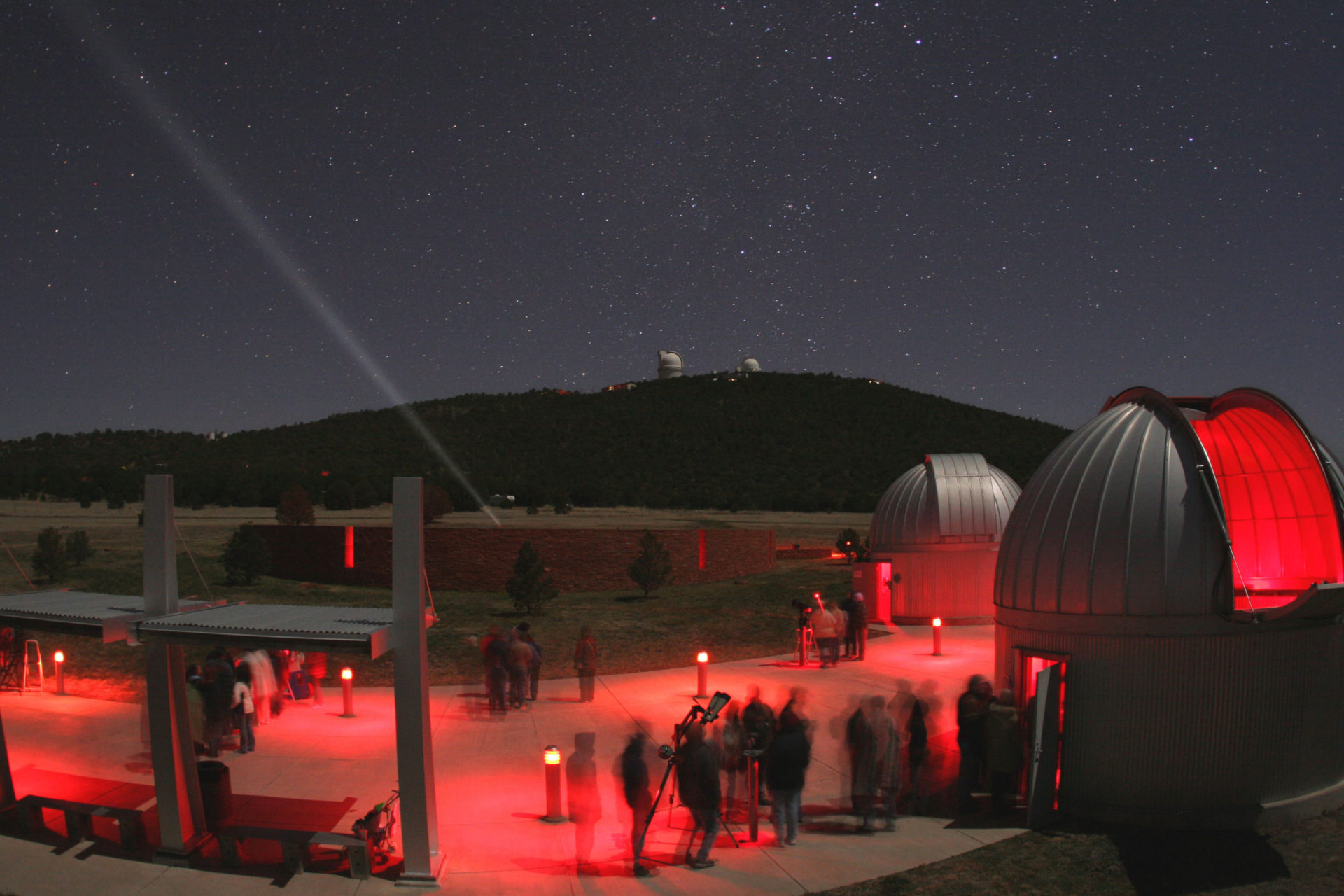
Today’s calls for exploring space are reminiscent of the supposed enthusiasm of the 1960s. As one version of the story goes, Americans during the Cold War were motivated by the desire to beat the Soviet Union in the space race. After winning the race to the Moon in 1969, however, Americans quickly lost interest — a trend exacerbated by the strife and malaise of the late sixties and the seventies. The triumph of the Moon landing therefore amounted to “a small step for Neil Armstrong, a giant leap for mankind and a real knee in the groin for NASA,” as Tom Wolfe put it.
But this story likely overstates the level of support the general public had for the space program even at its peak. Public polling in those days was an even more imperfect barometer of public opinion than it is today, with irregularly conducted surveys and inconsistent wording of questions across multiple iterations of the same surveys. Nevertheless, most of the available polls show that a solid plurality — and sometimes a majority — of Americans actually opposed the space program in its heyday (see Figure 1). Even in retrospect — after the success of the Apollo lunar landing — a majority of Americans at the time remained opposed. A Harris survey in April 1970 asked respondents whether, in retrospect, landing on the Moon was worth spending four billion dollars a year for nine years. Only 39 percent of respondents believed the endeavor was worth it, while 56 percent said it was not. That same year, a survey by the Philadelphia Sunday Bulletin found that 70 percent of its readers could not even remember the name of the man who first walked on the Moon — an event that over half of the country, and a fifth of the world, had witnessed on live television just one year earlier.
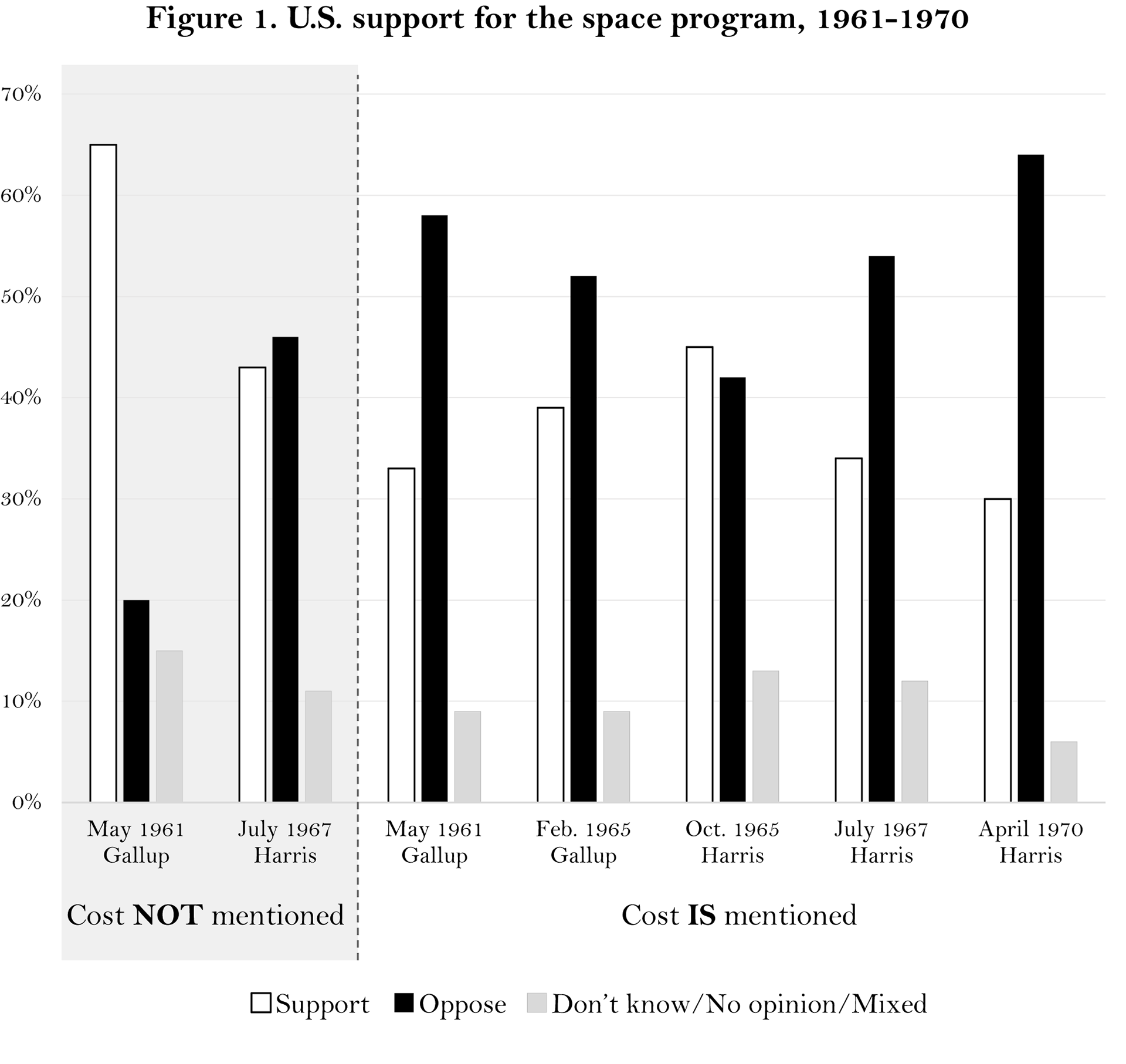
Notably, most of these polls mentioned that the space program cost $4 billion annually, or that it imposed a “considerable cost of federal money.” This framing likely swayed some respondents against the space program when they otherwise would have supported it. Unfortunately, we don’t have enough data to gauge how popular space exploration was when people weren’t informed of the cost. If the May 1961 Gallup poll is to be believed, the space program was twice as popular when the cost was not mentioned. By contrast, the July 1967 Harris poll indicates that a plurality of Americans opposed the space program even without knowing its price tag. So it’s an unanswerable question — as is, for that matter, whether we should lend greater credence to survey questions that inform respondents of tradeoffs or to those that don’t.
We can also compare how Americans felt about spending $4 billion on space compared to other government initiatives (see Figure 2). This comparison, based on a 1965 Harris poll, further emphasizes space exploration’s relative unpopularity, because respondents favored every single other priority over the space program. While the margins were narrow, they were roughly consistent — whatever the competing priority, 51 to 58 percent of Americans thought it should get the money that was going to the space program.

Of course, many of these other policy priorities were quite popular. So having at least 42 percent of respondents prioritize the space program over each of the other options could also indicate that the program enjoyed an impressive, irreducible popularity among a sizeable minority of the population. However, note that these results came from an outlier survey — the 1965 Harris poll was a rare instance when a plurality of respondents actually supported the space program. So perhaps this analysis overstates the program’s popularity. Either way, it’s clear that a majority of Americans opposed funding the space program when alternative destinations for that funding were available.
Americans weren’t just ambivalently exploring space on their own — they were also racing against the Soviet Union. Nowadays it’s difficult to separate our collective memory of 1960s space exploration from a supposed sense of urgency regarding the Soviets’ ambitions in space. But polling from the era indicates that most Americans were not that worried about competition with the Soviet Union, at least as far as space exploration was concerned. In 1964, only 26 percent of respondents agreed that Americans should “go all out to beat the Russians in a manned-flight to the moon,” while 66 percent said it was “not too important.” In 1967, only 33 percent of respondents deemed it important to try to send a man to the Moon before Russia. And in 1965, respondents were asked to pick their top three priorities for the government (see Figure 3). Only four percent selected “reaching the moon before Russia does.” Almost all other policy options were leagues ahead of the space race.

Does this mean that Cold War pressures had no impact on public opinion regarding space? Not necessarily. Fortunately, the 1965 and 1967 Harris surveys each included versions of the following two questions:
1. It could cost the United States $4 billion a year for the next few years to finally put a man on the moon and to explore other planets and outer space. All in all, do you feel the space program is worth spending that amount of money or do you feel it isn’t worth it? (See Figure 1 for the results to this question.)
2. If the Russians were not in space, and we were the only ones exploring space, would you favor or oppose continuing our space program at the present rate?
Both questions were broadly about whether people supported the U.S. space program, but only the second question focused on support if Russia had not been involved. So by comparing the answers to these two questions, we can estimate roughly how much public support for the space program was motivated specifically by the Cold War rivalry. This method of comparing the responses to two separate questions is imperfect, given that these questions involve other variables besides the mention of Russia — for example, only the first one mentions the cost of the space program — but it is likely the best we have. According to this method, the desire to best the U.S.S.R. appears to have slightly increased support for the space program (see Figure 4).

It is possible that respondents would have had a stronger reaction if the questions had asked about “the Soviets” or “the communists” rather than just “the Russians,” so these results may understate the impact of the rivalry on public opinion about space. Then again, the questions did make clear that “we were the only ones exploring space” in this hypothetical scenario. Once again, the dearth of data from the time period makes it impossible to arrive at a definitive conclusion. At the very least, however, these results indicate that the urgency of the space race against Russia as we remember it may have been felt more strongly by lawmakers and presidential administrations, and had only a marginal impact on the general population’s views regarding the space program. While President Lyndon Johnson famously said that he didn’t “believe that this generation of Americans is willing to resign itself to going to bed each night by the light of a Communist moon,” that fervency likely didn’t reflect the views of most Americans.
How has public opinion on space exploration changed between the 1960s and today? Fortunately, the polling data become much more robust by the early 1970s. The General Social Survey (GSS) has measured support for spending on space exploration regularly since 1973, providing us with an excellent baseline for comparing shifts in sentiment over the last fifty years (see Figure 5).

As we might expect, we can see massive opposition to funding space exploration in the early and mid-1970s, a time of great economic volatility. Approximately 60 percent of respondents believed that the country was spending too much on the program, while less than 10 percent believed spending was too low.
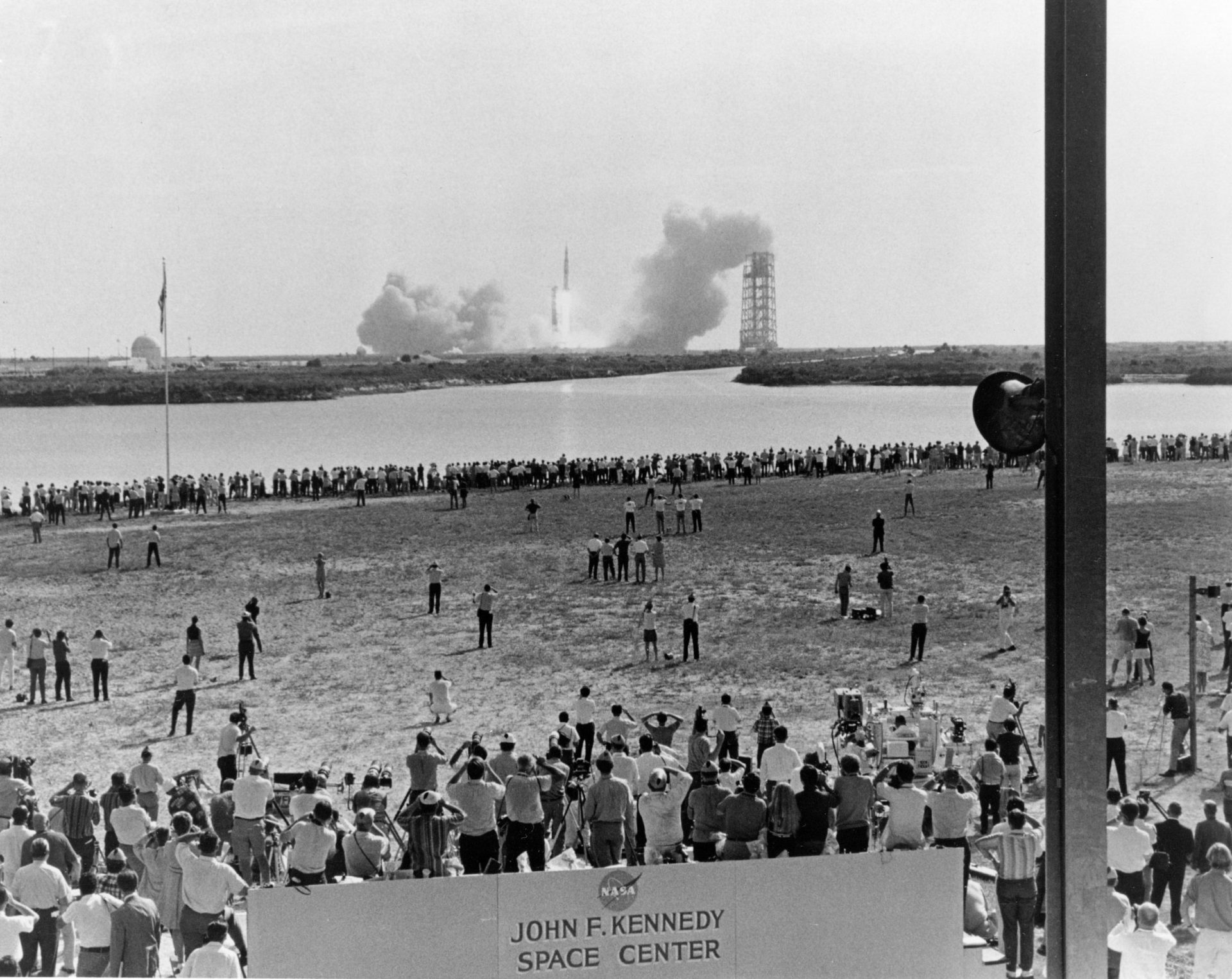
By the early 1980s, however, space had become less unpopular. Now only about 40 percent of respondents wanted to cut spending — roughly the same share as those who thought spending levels were “about right.” The reason for this shift from a decade earlier is unclear. The decline in the late 1970s in the number of people who thought we spent too much on space predates the economic boom and optimism of the 1980s. Perhaps this change can instead be attributed to science fiction films of the time, such as Star Wars and Close Encounters of the Third Kind. NASA’s budget also declined rapidly from its peak in the late 1960s, and as people became aware of these cuts they may have become more likely to see current space program spending as in line with their preferences. Whatever the cause, this pattern generally held until the turn of the millennium, with a spike in support in the late 1980s following the Challenger disaster and a dip during the early 1990s recession.
By the year 2000, support for existing spending levels became the clear plurality position of Americans, consistently hovering above 40 percent. And over the last twenty years, the rates of “too much” and “too little” responses began to converge — steadily more Americans supported more funding, and fewer wanted to cut back. This trend was gradual at first, with a steep jump in 2012. As of 2021, roughly the same share of Americans wanted to raise funding as wanted to lower it.
Looking at support for space by political party, we can see that Republicans have consistently been stronger proponents of space exploration than Democrats. They have been slightly more likely to support increased funding for the space program, and substantially less likely to want spending cuts (see Figure 6).

But the parties seem to be converging on this issue. As recently as 2008, the share of Democrats who said we were spending too much on space was 15 points higher than for Republicans. Last year, that gap was just four points. And the partisan gap among those who believe we’re spending too little has vanished completely. Much of this shift is because the share of Republicans calling for more spending has significantly declined, from 29 percent in 2014 down to 22 percent in 2021 (see footnote on page 97). Perhaps this decline is a reversion to the mean after the surge in support among Republicans starting in 2008, which could have been fueled by a general dissatisfaction with President Obama, or a more specific sense of disappointment in the space shuttle program’s retirement in 2011, and the embarrassment of NASA astronauts relying on Russia to get into space. Another explanation involves shifts in political coalitions during and after the Obama administration. Richer and more highly educated individuals are more likely to support space exploration. So as the GOP increasingly courts the working class and loses its college-educated voters, the party seems to be losing many of its pro-space constituents.
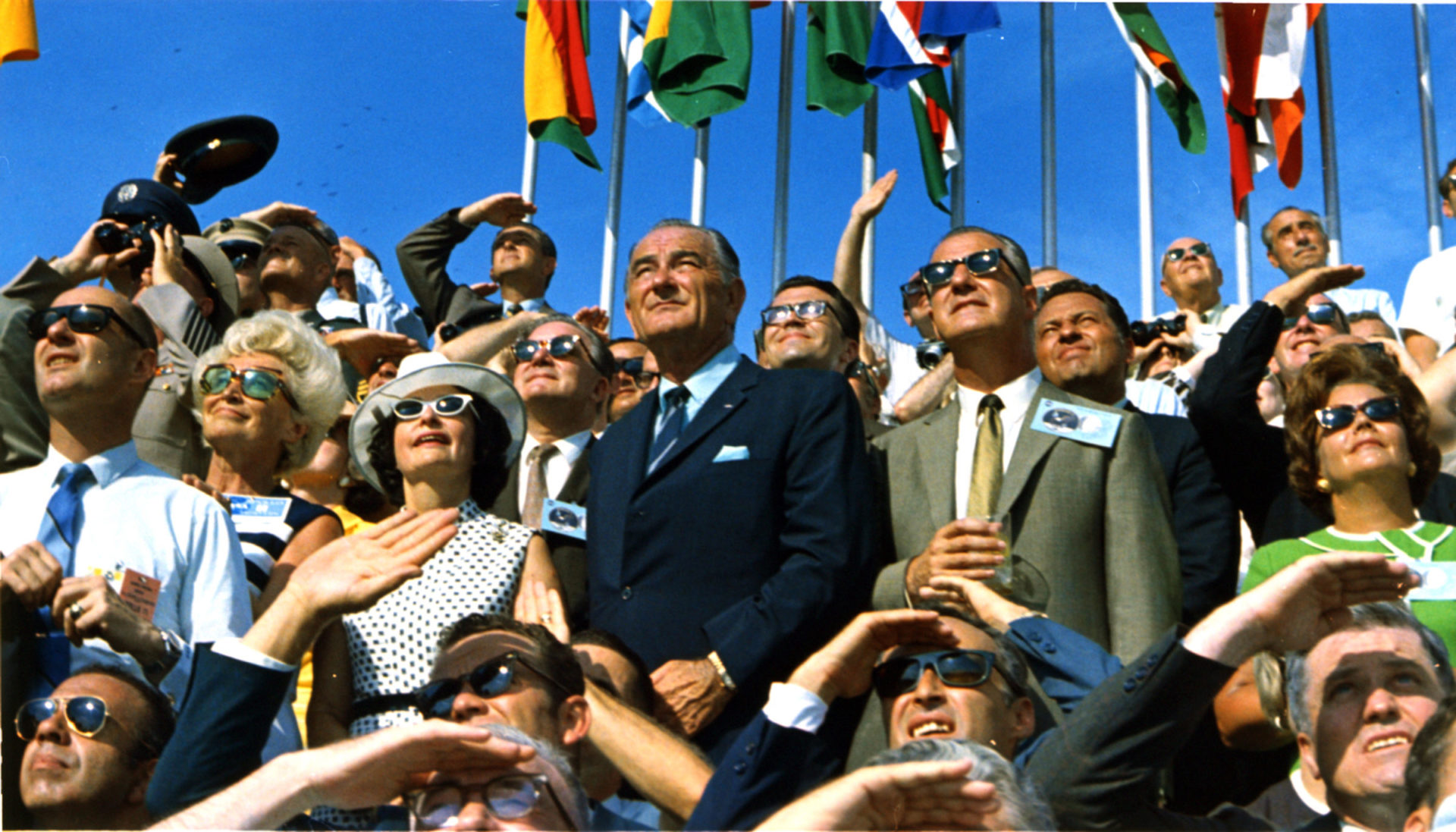
Overall, Americans’ opposition to space funding has declined markedly in the last fifty years. In 1973, 59 percent of the public thought we were spending too much on space exploration. In 2021, that number was down to 24 percent. This represents a tremendous reduction in the unpopularity of space funding. In the most recent survey, Americans were evenly split on whether they thought space exploration was overfunded or underfunded.
Compared to other government initiatives, however, the space program remains relatively low in popularity (see Figure 7). On most priorities, more Americans think the government is spending too little than think it is spending too much. But space exploration is one of the few exceptions. There are only four priorities that Americans are more likely to think are overfunded than they do space exploration: welfare (but not “assistance to the poor”), assistance to big cities (but not “solving the problems of big cities”), national defense, and foreign aid. And compared to space exploration, foreign aid is the only priority that fewer Americans think is underfunded.

Another way to get at the public’s sentiments about space is not by asking about financial support relative to other priorities, but simply about how interested people are in it compared to their interest in other issues (see Figure 8). The latest General Social Survey shows that 31 percent are “not at all interested” in issues about space exploration — an indifference rivaled only by “international and foreign policy issues” and “agricultural and farm issues.”

More recent polling corroborates these findings. A Morning Consult survey in February 2021 asked people to determine what should be the Biden administration’s top priorities. Out of a list of twenty-six options, so few respondents found “investing in space research and exploration” important that it ended up second-to-last — more important only than “overturning the global gag rule which prohibits government-funded foreign aid groups from discussing abortion.” So in terms of how much of the public ranks space as very important relative to other priorities, little has changed since the 1960s.
So far, we have been thinking of space exploration as a single issue. But of course, it is actually a variety of different activities: conducting research, remotely exploring the galaxy, sending people to the Moon and Mars, and much more. The public does not hold all these goals in equal regard.
According to the 2021 Morning Consult survey, Americans see the highest priority of the U.S. government’s space efforts as helping to protect the Earth. Sixty-three percent believed “monitoring key parts of the Earth’s climate system” should be an important or top priority, and 62 percent said so for “monitoring asteroids that could strike Earth” (see Figure 9). Between about a third and a half similarly prioritize other forms of space research — things like searching for new habitable planets, hunting for natural resources, and developing new technology. But only a third of Americans prioritize sending astronauts to the Moon or Mars. A majority are ambivalent (“not too important of a priority” or “don’t know”) about both goals, while another 12 percent say they “should not be done.”

A May 2019 AP-NORC survey found very similar results: When asked about the priorities of the U.S. space program, respondents favored protecting the Earth, while scientific research and remote exploration enjoyed moderate prioritization, and projects to travel to the Moon and Mars or otherwise expand into space were deemed by far the least important.
Returning to the Moon and traveling to Mars may be the most-discussed aims of space exploration, but they are also the least popular among the general public — consistently, in fact. When the AP-NORC survey asked respondents whether the U.S. space program should prioritize sending astronauts back to the Moon, going to Mars, or neither, 18 percent favored the Moon, 37 percent preferred Mars, and 43 percent favored neither. And when asked directly about returning to the Moon by 2024, only a slim plurality of 42 percent of respondents were in favor, with 20 percent opposing the goal and 38 percent neither favoring nor opposing it.
Similarly, when a 2019 CBS poll asked about providing NASA with an additional $1.6 billion in order to send U.S. astronauts to the Moon by 2024, 45 percent of respondents deemed this a “good use of money,” while 52 percent thought the money would be better spent elsewhere. However, this same poll also had some good news for Moon advocates. When costs or alternate priorities were not mentioned, 71 percent of Americans favored sending astronauts back to the Moon, and 76 percent felt the same way about Mars. This was a marked improvement over 1999, when both destinations received only 58 percent support. That’s consistent with the general increase in support for space exploration over the past twenty years.
So America’s renewed commitment to travel to the Moon and Mars is not just a reflection of space entrepreneurs’ and politicians’ newfound enthusiasm — the public, too, shows growing support. Nevertheless, it’s clear that much of the public enthusiasm evaporates in the face of tradeoffs on Earth and competing priorities in space.
So what do Americans think about the privatization of space?
In July 1988, a Rockwell International survey gauged public opinion on the entry of private companies into the space industry — on whether they agreed that “because NASA has a good overall record of managing the civilian space program, proposals to shift some of NASA’s responsibilities to private industry are a bad idea.” Fifty-eight percent of respondents agreed that privatization was a bad idea. Similarly, when asked whether “the U.S. civilian space program is too big an activity to turn over to private companies,” 61 percent agreed. Even when asked whether America should make this shift “because private enterprise is more effective than government,” 52 percent still disagreed.
A lot has changed since the 1980s, with private companies such as SpaceX and Blue Origin developing capabilities that often outstrip those of NASA. In this new context, Americans support a mix of public and private involvement in space, though they still offer a stronger endorsement of the public sector.
Why the continued support for government leadership in space? For starters, NASA has a good reputation among Americans — according to 2019 Gallup polls, nearly two thirds of Americans say NASA is doing a good or excellent job, whereas only a third gave fair or poor ratings. In addition, Americans have warmed up to the recently established Space Force: While only a little over a third of Americans supported establishing it when it was announced in the summer of 2018, the 2021 Morning Consult survey found that almost two thirds of Americans now support President Biden’s decision to keep it.
By contrast, Americans may show less support for private space companies because they don’t believe the companies can be profitable yet, or they might be skeptical that private actors will conduct business in space responsibly. Results from a 2018 Pew survey point to the latter explanation: 80 percent of Americans have at least a fair amount of confidence that private companies will make a profit in space, and 77 percent are confident that these companies will build safe and reliable spacecraft. But only 48 percent believe that the companies will minimize the debris from their rockets and satellites.
So it comes as no surprise that a strong majority (two thirds) of Americans still recognize a need for NASA’s continued involvement, and only a third believe private companies will “ensure that enough progress is made in space exploration” on their own. As of 2019, far more Americans still believe that the government should play a major role in advancing space exploration and research (60 percent) than say the same of private companies (41 percent). Still, only a small share of Americans believe private enterprise should have no role at all (14 percent). Rather, they see the private sector as a supplement. Only 15 percent of Americans believe that NASA and the federal government should carry out everything in space, 8 percent say the same for private companies, and 70 percent believe a “mix of both” private and public efforts should be involved.
The 2021 Morning Consult poll finds similar results (see Figure 10). Americans tend to believe that the federal space program is better prepared than private industry to handle most goals of the space program, with the exceptions of sending civilians to the Moon or Mars and developing new technology.

Notably, respondents did not actually think federal space agencies are best prepared to achieve goals in space. Instead, for nearly all goals, international space partnerships outstripped both federal agencies and private industries as respondents’ top choice. So for many Americans — in stark contrast to the space race era — exploring space is less a national project and more a global endeavor.
It is possible that a new international space race could once again spur public opinion at the margin, just as it did in the 1960s. The U.S. director of national intelligence’s 2021 threat assessment report notes that China is working to develop capabilities in space that “match or exceed” those of the United States, and China successfully landed its first rover on Mars last year. The country is also working to put a station on the Moon in partnership with Russia, which is currently ratcheting up its own military capabilities in space. Currently, around half of Americans are seriously concerned about international space competition — 52 percent perceive China as a “major threat” to U.S. leadership in space research and 45 percent do so for Russia, according to the Morning Consult poll. For both countries, only 7 percent perceive no threat at all, and 23 percent have no opinion. Collectively, Americans seem to be somewhat conscious of strong international competition, but far from overwhelmingly so.
Despite this collective ambivalence, most Americans want their country to be on the international space stage in some form: As of 2018, 72 percent believe it’s “essential” for America to continue to be a world leader in space exploration. But there’s a difference between being the leader and being a leader. Only 17 percent of Americans in 2019 considered the United States to be “the leading nation” in space exploration, with another 64 percent regarding America as “one of several” leading nations. The 2019 CBS poll even shows that 43 percent of Americans believe the U.S. has started to fall behind other countries in space exploration, whereas 46 percent still regard America as the world leader. Moreover, the poll shows that about half the country would be comfortable if America no longer led in space — 43 percent believe the U.S. should continue to be involved in space but does not need to lead, and another 7 percent believe America doesn’t really need to be involved in space exploration anymore.
It’s easy to overestimate the level of support the general public has for the space program. Even in the 1960s, a plurality or majority of Americans probably opposed efforts to put a man on the Moon, prioritizing many other uses of government resources above the space program. And while the public’s favorability toward space exploration has markedly increased over the past two decades, ardent space advocates should recognize both that space still ranks quite low among Americans’ policy priorities, and that most Americans care little for projects such as traveling to the Moon and Mars, instead preferring Earth-centered space activity such as watching out for asteroids or monitoring the climate.
Perhaps a new international space race will emerge. But roughly half of Americans are not strongly concerned about such threats, a plurality actually favors an internationalist space program, and the precedent set by the 1960s indicates that an international threat may not have a large impact on public opinion about space.
The New Atlantis publishes one-of-a-kind thought leadership on science and tech
Should space enthusiasts come away from these results with a pessimistic outlook? Not necessarily. From their perspective, the public-opinion story of the last twenty years is one of tremendous improvement. Instead, these results should lead them to ponder the following question: How much public support is actually necessary for a sustainable push into space?
If the 1960s are any indication, the answer may be “not much.” After all, public funding for NASA is a mere drop in the bucket — at around $25 billion a year, it is less than half of one percent of all federal spending, and so it would not be difficult to afford increased budgets for the program. Plus, private space companies will likely continue to push forward independently of public demands. So space optimists also have that to look forward to.
Still, advocates for space exploration shouldn’t fool themselves. They have made great progress in shifting public opinion over the years, but they will continue to have their work cut out for them for the foreseeable future.